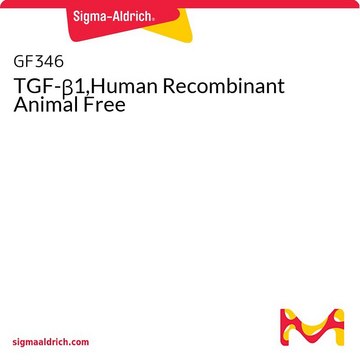Wszystkie zdjęcia(1)
Kluczowe dokumenty
L3408
Transforming Growth Factor-β1 Latency Associated Peptide human
≥97% (SDS-PAGE), recombinant, expressed in Sf21 cells, lyophilized powder, suitable for cell culture
Synonim(y):
LAP, TGF-β1
Zaloguj sięWyświetlanie cen organizacyjnych i kontraktowych
About This Item
Polecane produkty
pochodzenie biologiczne
human
Poziom jakości
rekombinowane
expressed in Sf21 cells
Próba
≥97% (SDS-PAGE)
Formularz
lyophilized powder
masa cząsteczkowa
protein 70 kDa
metody
cell culture | mammalian: suitable
zanieczyszczenia
endotoxin, tested
przydatność
suitable for molecular biology
numer dostępu UniProt
temp. przechowywania
−20°C
informacje o genach
human ... TGFB1(7040)
Opis ogólny
Research Area: Cell Signaling
TGF-β is released from degranulating platelets and secreted from nearly all cells in a biologically inactive complex which is unable to bind to cellular receptors and is not recognized by antibodies to TGF-β. The peptide can be activated by acidification, alkalinization, or action of chaotropic agents in vitro. The complex consists of TGF-β associated non-covalently with a protein designated as the latency associated peptide (LAP). TGF-β and LAP represent components of a pro-peptide that is cleaved in a post-golgi compartment prior to secretion. The recombinant human LAP is produced from a DNA sequence corresponding to the 278 amino acid residues of pre-pro-TGF-β1 terminating prior to the mature TGF-β1. LAP contains a Cys33 to Ser33 substitution. LAP contains 249 amino acids, generated after cleavage of a 29 amino acid residue signal peptide. LAP is a glycoslyated, disulfide linked homodimer.
TGF-β is released from degranulating platelets and secreted from nearly all cells in a biologically inactive complex which is unable to bind to cellular receptors and is not recognized by antibodies to TGF-β. The peptide can be activated by acidification, alkalinization, or action of chaotropic agents in vitro. The complex consists of TGF-β associated non-covalently with a protein designated as the latency associated peptide (LAP). TGF-β and LAP represent components of a pro-peptide that is cleaved in a post-golgi compartment prior to secretion. The recombinant human LAP is produced from a DNA sequence corresponding to the 278 amino acid residues of pre-pro-TGF-β1 terminating prior to the mature TGF-β1. LAP contains a Cys33 to Ser33 substitution. LAP contains 249 amino acids, generated after cleavage of a 29 amino acid residue signal peptide. LAP is a glycoslyated, disulfide linked homodimer.
Zastosowanie
Latency Associated Peptide (LAP) may be used to inhibit transforming growth factor-β 1 activity in various biological systems.
Transforming Growth Factor-β1 Latency Associated Peptide human has been used to coat the cell culture inserts for cell migration assays to determine the functional effects of impeding αvβ6 endocytosis in vitro. It has also been used to coat non-tissue culture-treated 96-well plates for adhesion assays.
Działania biochem./fizjol.
Latency Associated Peptide (LAP) binds transforming growth factor-beta 1 (TGF-β1) to form a latent complex. The activity of TGF-β1 is primarily regulated through the activation of the latent molecule. LAP has the ability to stimulate epithelial cell migration, representing a new function for LAP in controlling monocyte trafficking and immune modulation. Following post-translational modification, TGF-β1 binds non-covalently to the LAP to establish latency. Due to its crucial function in modulating TGF-β1 activity, LAP plays a fundamental role in governing a range of TGF-β1 effects. LAP is expressed on immature dendritic cells and contributes to T cell differentiation. LAP exhibits both chemotactic and anti-inflammatory activity independently of active TGF-β1.
TGF-β1 is produced by many cell types, but is reported to be most concentrated in mammalian platelets, where it is present at approximately four times the level of TGF-β2.
Postać fizyczna
Lyophilized from 0.2 μm filtered phosphate buffered saline containing 1.25 mg bovine serum albumin.
Komentarz do analizy
The biological activity is measured by its ability to inhibit TGF-β1 activity on mouse HT-2 cells.
Oświadczenie o zrzeczeniu się odpowiedzialności
Unless otherwise stated in our catalog or other company documentation accompanying the product(s), our products are intended for research use only and are not to be used for any other purpose, which includes but is not limited to, unauthorized commercial uses, in vitro diagnostic uses, ex vivo or in vivo therapeutic uses or any type of consumption or application to humans or animals.
Ta strona może zawierać tekst przetłumaczony maszynowo.
Kod klasy składowania
11 - Combustible Solids
Klasa zagrożenia wodnego (WGK)
WGK 3
Temperatura zapłonu (°F)
Not applicable
Temperatura zapłonu (°C)
Not applicable
Środki ochrony indywidualnej
Eyeshields, Gloves, type N95 (US)
Wybierz jedną z najnowszych wersji:
Masz już ten produkt?
Dokumenty związane z niedawno zakupionymi produktami zostały zamieszczone w Bibliotece dokumentów.
Muge Sarper et al.
Breast cancer research : BCR, 19(1), 33-33 (2017-03-24)
Normal myoepithelial cells (MECs) play an important tumour-suppressor role in the breast but display an altered phenotype in ductal carcinoma in situ (DCIS), gaining tumour-promoter functions. Matrix metalloproteinase-8 (MMP-8) is expressed by normal MECs but is lost in DCIS. This
Nasz zespół naukowców ma doświadczenie we wszystkich obszarach badań, w tym w naukach przyrodniczych, materiałoznawstwie, syntezie chemicznej, chromatografii, analityce i wielu innych dziedzinach.
Skontaktuj się z zespołem ds. pomocy technicznej




